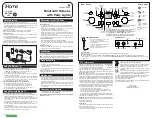
3.0.
COLLECTOR LOCATION, ORIENTATION AND TILT
Your solar water system will be providing savings for
your family for decades to come. Because the sun rises
in the east, crosses over the horizon on the south and
sets in the west, you want your collector to face as much
to the south as possible.
Your system needs the most
sun it can get!
As long as the collector angle (known as tilt) is at least
14 degrees up from horizontal, (a typical roof angle is
14 to 28 degrees) additional tilt usually has little effect
on total year round performance.
The exception
is in
areas with very sunny winters (as in most areas of
Colorado) where a higher angle, (facing the collector
more directly into the winter sun) can help year round
performance.
In most areas with
heavy winter overcast,
a solar
collector's orientation on a low pitched roof can face
anywhere from 45 degrees east to west of south without
losing more than 8% of the energy it would have
produced if it were facing directly south. At 90 degrees
east to west of south the loss is closer to 20%.
Exceptions include
easterly facing systems in areas
with a lot of morning fog and clear afternoons where
south facing or west facing would be much better. The
opposite can be true if sunny mornings are very often
followed by rainy afternoons.
Take these facts into consideration when locating
your collector and consult with us if you have any
questions.
ROOF CONDITION:
The condition of your roof should be good although one
of the features of the Fireball 2001 system is that
removing and replacing the collector is relatively easy
for re-roofing.
Summary of Contents for Fireball 20014
Page 2: ......









































